The NVIDIA GeForce GTX 980 Ti Review
by Ryan Smith on May 31, 2015 6:00 PM ESTNVIDIA's Computex Announcements & The Test
Alongside the launch of the GTX 980 Ti, NVIDIA is also taking advantage of Computex to make a couple of other major technology announcements. Given the scope of these announcements we’re covering these in separate articles, but we’ll quickly go over the high points here as they pertain to the GTX 980 Ti.
G-Sync Variable Overdrive & Windowed Mode G-Sync
NVIDIA is announcing a slew of G-Sync products/technologies today, the most important of which is Mobile G-Sync for laptops. However as part of that launch, NVIDIA is also finally confirming that all G-Sync products, including existing desktop G-Sync products, feature support for G-Sync variable overdrive. As the name implies, this is the ability to vary the amount of overdrive applied to a pixel based on a best-effort guess of when the next frame will arrive. This allows NVIDIA to continue to use pixel overdrive on G-Sync monitors to improve pixel response times and reduce ghosting, at a slight cost to color accuracy while in motion from errors in the frame time predictions.
Variable overdrive has been in G-Sync since the start, however until now NVIDIA has never confirmed its existence, with NVIDIA presumably keeping quiet about it for trade secret purposes. However now that displays supporting AMD’s Freesync implementation of DisplayPort Adaptive-Sync are out, NVIDIA is further clarifying how G-Sync works.
Meanwhile being freshly rolled out in NVIDIA’s latest drivers is support for Windowed Mode G-Sync. Before now, running a game in Windowed mode could cause stutters and tearing because once you are in Windowed mode, the image being output is composited by the Desktop Window Manager (DWM) in Windows. Even though a game might be outputting 200 frames per second, DWM will only refresh the image with its own timings. The off-screen buffer for applications can be updated many times before DWM updates the actual image on the display.
NVIDIA will now change this using their display driver, and when Windowed G-Sync is enabled, whichever window is the current active window will be the one that determines the refresh rate. That means if you have a game open, G-Sync can be leveraged to reduce screen tearing and stuttering, but if you then click on your email application, the refresh rate will switch back to whatever rate that application is using. Since this is not always going to be a perfect solution - without a fixed refresh rate, it's impossible to make every application perfectly line up with every other application - Windowed G-Sync can be enabled or disabled on a per-application basis, or just globally turned on or off.
GameWorks VR & Multi-Res Shading
Also being announced at Computex is a combination of new functionality and an overall rebranding for NVIDIA’s suite of VR technologies. First introduced alongside the GeForce GTX 980 in September as VR Direct, NVIDIA will be bringing their VR technologies in under the GameWorks umbrella of developer tools. The collection of technologies will now be called GameWorks VR, adding to the already significant collection of GameWorks tools and libraries.
On the feature front, the newly minted GameWorks VR will be getting a new feature dubbed Multi-Resolution Shading, or Multi-Res Shading for short. With multi-res shading, NVIDIA is looking to leverage the Maxwell 2 architecture’s Multi-Projection Acceleration in order to increase rendering efficiency and ultimately the overall performance of their GPUs in VR situations.
By reducing the resolution of video frames at the edges where there is already the most optical distortion/compression and the human eye is less sensitive, NVIDIA says that using multi-res shading can result in a 1.3x to 2x increase in pixel shader performance without noticeably compromising the image quality. Like many of the other technologies in the GameWorks VR toolkit this is an implementation of a suggested VR practice, however in NVIDIA’s case the company believes they have a significant technological advantage in implementing it thanks to multi-projection acceleration. With MPA to bring down the rendering cost of this feature, NVIDIA’s hardware can better take advantage of the performance advantages of this rendering approach, essentially making it an even more efficient method of VR rendering.
Getting Behind DirectX Feature Level 12_1
Finally, though not an outright announcement per-se, from a marketing perspective we should expect to see NVIDIA further promote their current technological lead in rendering features. The Maxwell 2 architecture is currently the only architecture to support DirectX feature level 12_1, and with DirectX 12 games due a bit later this year, NVIDIA sees that as an advantage to press.
For promotional purposes NVIDIA has put together a chart listing the different tiers of feature levels for DirectX 12, and to their credit this is a simple but elegant layout of the current feature level situation. The bulk of the advanced DirectX 12 features we saw Microsoft present at the GTX 980 launch are part of feature level 12_1, while the rest, and other functionality not fully exploited under DirectX 11 are part of the 12_0 feature level. The one exception to this is volume tiled resources, which is not part of either feature level and instead is part of a separate feature list for tiled resources that can be implemented at either feature level.
The Test
The press drivers for the launch of the GTX 980 Ti are release 352.90, which other than formally adding support for the new card is otherwise identical to the standing 352.86 drivers.
| CPU: | Intel Core i7-4960X @ 4.2GHz |
| Motherboard: | ASRock Fatal1ty X79 Professional |
| Power Supply: | Corsair AX1200i |
| Hard Disk: | Samsung SSD 840 EVO (750GB) |
| Memory: | G.Skill RipjawZ DDR3-1866 4 x 8GB (9-10-9-26) |
| Case: | NZXT Phantom 630 Windowed Edition |
| Monitor: | Asus PQ321 |
| Video Cards: | AMD Radeon R9 295X2 AMD Radeon R9 290X AMD Radeon HD 7970 NVIDIA GeForce GTX Titan X NVIDIA GeForce GTX 980 Ti NVIDIA GeForce GTX 980 NVIDIA GeForce GTX 780 Ti NVIDIA GeForce GTX 780 NVIDIA GeForce GTX 680 NVIDIA GeForce GTX 580 |
| Video Drivers: | NVIDIA Release 352.90 Beta AMD Catalyst Cat 15.5 Beta |
| OS: | Windows 8.1 Pro |


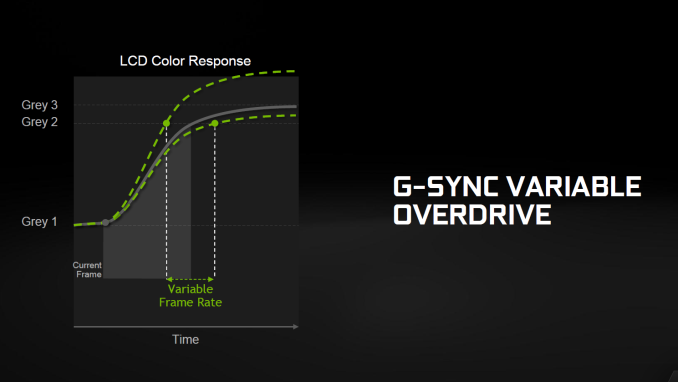
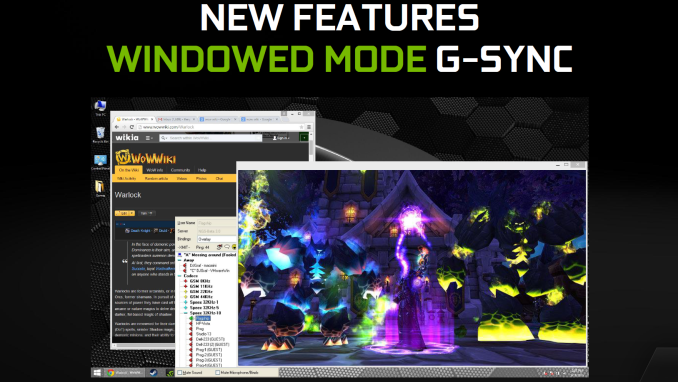
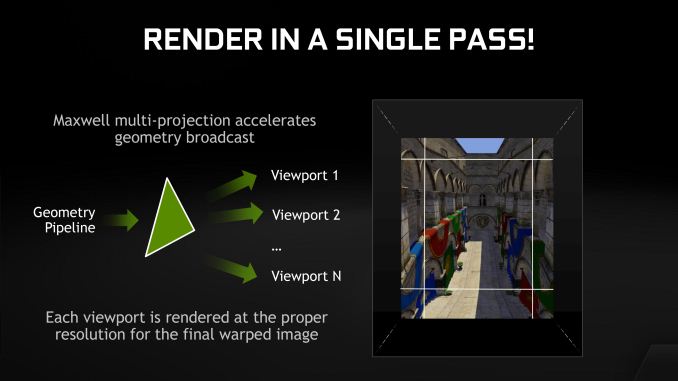
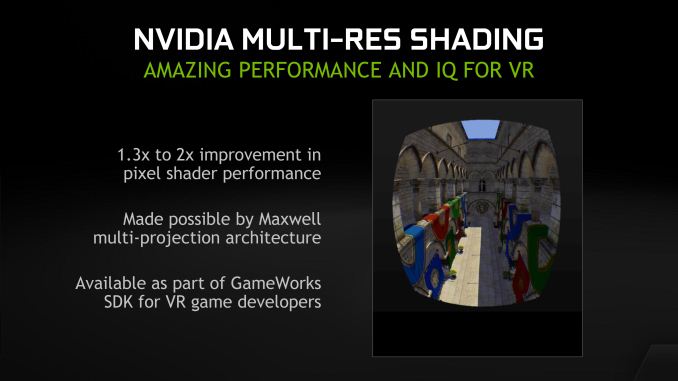
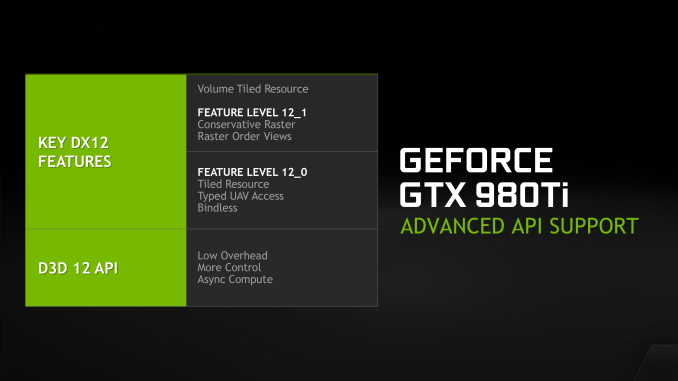








290 Comments
View All Comments
Oxford Guy - Monday, June 1, 2015 - link
I'm sure you posted that from your 65nm processor and 80nm GPU.godrilla - Thursday, June 4, 2015 - link
Because next shrink is in the 3d chips plus hbm category and that should be amazing performance leap.Gastec - Sunday, September 4, 2016 - link
Oh yeah, that's "1337 5p34k" for ya! :PWreckage - Sunday, May 31, 2015 - link
Wait until AMD tries to sell you a rebadge for that much.Rezurecta - Sunday, May 31, 2015 - link
I don't understand the rage about rebadge all of a sudden. GPU has been doing this for YEARS!Anyway, nice card from Nvidia for a decent price.
dragonsqrrl - Sunday, May 31, 2015 - link
Don't mix up traditional rebadging and what AMD is doing with their upcoming lineup, it's unprecedented. It's also worrisome, and it's clearly a big problem for AMD. What does it say about the state of the company and their R&D budget that they'll only have 1 new GPU this coming generation? One of the big problems AMD is currently facing, amongst many other things, are their profit margins. In order to compete they're selling larger, more expensive GPU's attached to more complex memory interfaces relative to the competition, and that won't change much this coming generation as a result of these top to bottom rebadges. The situation is really becoming quite analogous to their CPU's, which should raise alarms for any informed enthusiast. It's a less than ideal situation, to put it lightly.Azix - Sunday, May 31, 2015 - link
If you post this after their launch then maybe I'd understand. As it is their Chips are almost certainly not rebadged because they aren't on TSMC and will include hardware improvements. They maybe be based on hawaii or w/e but not even nvidia managed to put out more than 2 new cards during their major launch last year. Considering this is likely the last year of 28nm launches, it may make sense for them to put out an entire line of modified chips and be done with the 300 series. Keeping it fresh till next year when they can do 2-3 on a smaller process.dragonsqrrl - Sunday, May 31, 2015 - link
"If you post this after their launch then maybe I'd understand."You realize I could just give the exact same response to the rest of your comment. But I won't.
"As it is their Chips are almost certainly not rebadged because they aren't on TSMC and will include hardware improvements.",
That's interesting, I haven't heard anything about AMD switching fabs for the 300 series. Source?
"They maybe be based on hawaii or w/e but not even nvidia managed to put out more than 2 new cards during their major launch last year."
Not quite a straight comparison there, since Nvidia also launched a new architecture with the 750Ti. Thus far we've gotten 4 new GPU's (not just cards) based on Maxwell. And we're not just talking launch here. All indications point to Fiji as the only new GPU of the coming generation for AMD. And what's more, it might not even be an updated architecture. The rest of the lineup will likely be refreshes of Hawaii, Tonga, Pitcairn, and Bonaire, ranging from GCN 1.2-1.0, with at most manufacturing revisions to improve efficiency. Again it's very important to put this in perspective, in the context of what these GPU's will be competing against. They range in feature set, and in power efficiency, none of which is anywhere close to par with Maxwell, and it's going to be very difficult for AMD to compete with this lineup for another generation. It's not a good situation for AMD. "Keeping it fresh"? How you came to spin your conclusion the way you did is beyond me.
ImSpartacus - Monday, June 1, 2015 - link
Be nice. The guy is basically telling you at this point.ImSpartacus - Monday, June 1, 2015 - link
trolling***